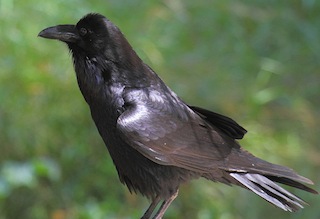 The highly intelligent Raven has great aerial ability given its large size.
The highly intelligent Raven has great aerial ability given its large size.
Photo: © Richard Birchett
Scientific name: Corvus corax
Other common names: Northern Raven, Common Raven
Cornish name: Marghvran
Conservation status: UK Birds of Conservation Concern, Green; IUCN Red List, Least Concern
What to look for:
- Colouring and appearance: Very large black bird, black bill and legs
- Size: Length 64 cm, wingspan 135 cm
- Where: The Raven is resident in Britain, and breeds in the north and west, including the south-west
- Call: Croaking call
- Similar species: Carrion Crow, Rook
 The Raven is an impressive bird. The largest member of the crow family, and as big as a Buzzard, it has black feathers, a black bill and legs, and a large wingspan. Despite its size, however, it is very wary and shy.
The Raven is an impressive bird. The largest member of the crow family, and as big as a Buzzard, it has black feathers, a black bill and legs, and a large wingspan. Despite its size, however, it is very wary and shy.
In flight it can easily be distinguished from other corvids by its V-shaped tail and long narrow wings. Ravens breed on upland heaths, moors and coastal clifftops across Europe, northern Africa and Asia, as well as northern America. Here, they mainly breed in the western half of Britain, so the famous Ravens of the Tower of London are a little far from home.
Birds pair for life, producing four to six eggs in the spring that are incubated for 21 to 22 days in a nest made of sticks, placed high in a tree or on a cliff ledge. After hatching, the young take about 40 days to fledge, and become sexually mature at three years old. Ravens are opportunistic, omnivorous feeders, mainly relying on carrion. The maximum recorded age of wild birds is almost 18 years, but the more pampered Ravens of the Tower can live for much longer.
The collective noun for Ravens is an unkindness: somewhat unfair for this intelligent, acrobatic and playful bird. It is a bird steeped in the folklore of Britain. Ravens were associated with Odin, the god of Norse mythology, and gathered information for him from across the world. They were also associated with Apollo in Greek mythology. The god sent a white raven to see if his lover, Coronis, was faithful. When the Raven reported that he was not, Apollo burnt the Raven’s feathers black in a fit of anger, and Ravens have been black ever since.
Did you know…?
…Repeating itself: the genus and species names both mean Raven: Corvus is Latin and corax is Greek.
…According to legend, at least six Ravens must be kept at the Tower of London, otherwise the Kingdom will meet great disaster. One of the ‘Beefeaters’ is charged with caring for the Tower’s Ravens.

More information and references:
Svensson, L., Mullarney, K., Zetterstrom, D.,1986. Collins Bird Guide, second edition (translated by Christie, D., Svensson, L.). HarperCollins, London.
Published: November 2014 (updated January 2020)
Author: Amanda Scott
Photos: Upper – Ilya Maclean; Lower of Ravens at Ogo Dour Cove, Mullion – © Richard Birchett
